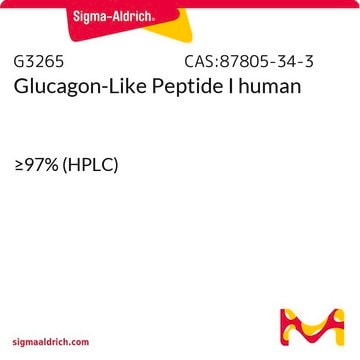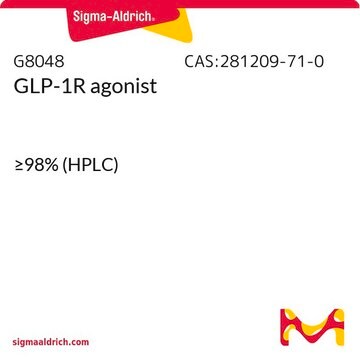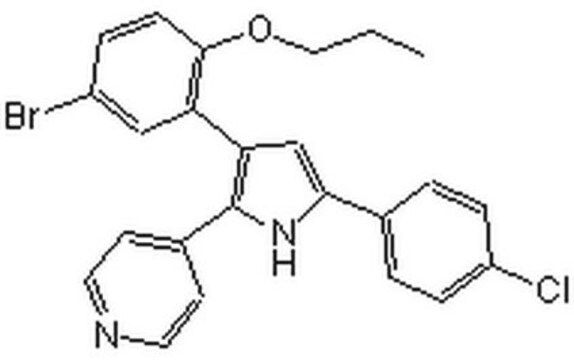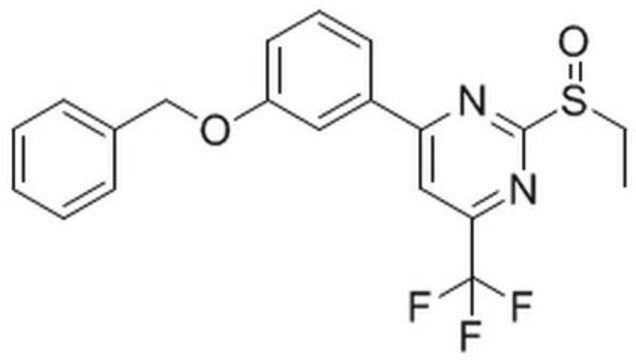E7269
Exendin Fragment 9-39
≥95% (HPLC)
About This Item
Productos recomendados
Nivel de calidad
Análisis
≥95% (HPLC)
formulario
powder
mol peso
3369.76 g/mol
condiciones de almacenamiento
(Keep container tightly closed in a dry and well-ventilated place)
técnicas
protein expression: suitable
solubilidad
water: 1.00-1.04 mg/mL, clear, colorless
temp. de almacenamiento
−20°C
InChI
1S/C149H234N40O47S/c1-14-78(10)120(185-139(227)98(62-81-29-16-15-17-30-81)177-136(224)97(61-76(6)7)175-129(217)88(35-24-53-158-149(156)157)172-144(232)119(77(8)9)184-122(210)79(11)164-126(214)90(41-46-114(199)200)168-131(219)91(42-47-115(201)202)169-132(220)92(43-48-116(203)204)170-134(222)94(50-58-237-13)171-130(218)89(40-45-109(153)194)167-127(215)86(33-20-22-51-150)166-140(228)103(72-192)182-137(225)95(59-74(2)3)174-123(211)84(152)64-118(207)208)145(233)173-93(44-49-117(205)206)133(221)178-99(63-82-66-159-85-32-19-18-31-83(82)85)138(226)176-96(60-75(4)5)135(223)165-87(34-21-23-52-151)128(216)179-100(65-110(154)195)124(212)161-67-111(196)160-69-113(198)186-54-25-36-105(186)142(230)183-104(73-193)141(229)181-102(71-191)125(213)162-68-112(197)163-80(12)146(234)188-56-27-38-107(188)148(236)189-57-28-39-108(189)147(235)187-55-26-37-106(187)143(231)180-101(70-190)121(155)209/h15-19,29-32,66,74-80,84,86-108,119-120,159,190-193H,14,20-28,33-65,67-73,150-152H2,1-13H3,(H2,153,194)(H2,154,195)(H2,155,209)(H,160,196)(H,161,212)(H,162,213)(H,163,197)(H,164,214)(H,165,223)(H,166,228)(H,167,215)(H,168,219)(H,169,220)(H,170,222)(H,171,218)(H,172,232)(H,173,233)(H,174,211)(H,175,217)(H,176,226)(H,177,224)(H,178,221)(H,179,216)(H,180,231)(H,181,229)(H,182,225)(H,183,230)(H,184,210)(H,185,227)(H,199,200)(H,201,202)(H,203,204)(H,205,206)(H,207,208)(H4,156,157,158)/t78-,79-,80-,84-,86-,87-,88-,89-,90-,91-,92-,93-,94-,95-,96-,97-,98-,99-,100-,101-,102-,103-,104-,105-,106-,107-,108-,119-,120-/m0/s1
Clave InChI
WSEVKKHALHSUMB-MVNVRWBSSA-N
Información sobre el gen
human ... GCG(2641) , GLP1R(2740)
Amino Acid Sequence
Aplicación
- to study to determine whether Ex-4 a GLP-1R agonist acts through GLP-1R, in mouse skeletal muscle cell line
- to study its effects on the adaptation of islets in glucose-dependent insulinotropic polypeptide knockout mice
- to study its in vivo effects on GLP-1 signaling on insulin response in mice
Acciones bioquímicas o fisiológicas
Otras notas
Producto relacionado
Código de clase de almacenamiento
11 - Combustible Solids
Clase de riesgo para el agua (WGK)
WGK 3
Punto de inflamabilidad (°F)
Not applicable
Punto de inflamabilidad (°C)
Not applicable
Equipo de protección personal
Eyeshields, Gloves, type N95 (US)
Certificados de análisis (COA)
Busque Certificados de análisis (COA) introduciendo el número de lote del producto. Los números de lote se encuentran en la etiqueta del producto después de las palabras «Lot» o «Batch»
¿Ya tiene este producto?
Encuentre la documentación para los productos que ha comprado recientemente en la Biblioteca de documentos.
Los clientes también vieron
Nuestro equipo de científicos tiene experiencia en todas las áreas de investigación: Ciencias de la vida, Ciencia de los materiales, Síntesis química, Cromatografía, Analítica y muchas otras.
Póngase en contacto con el Servicio técnico








